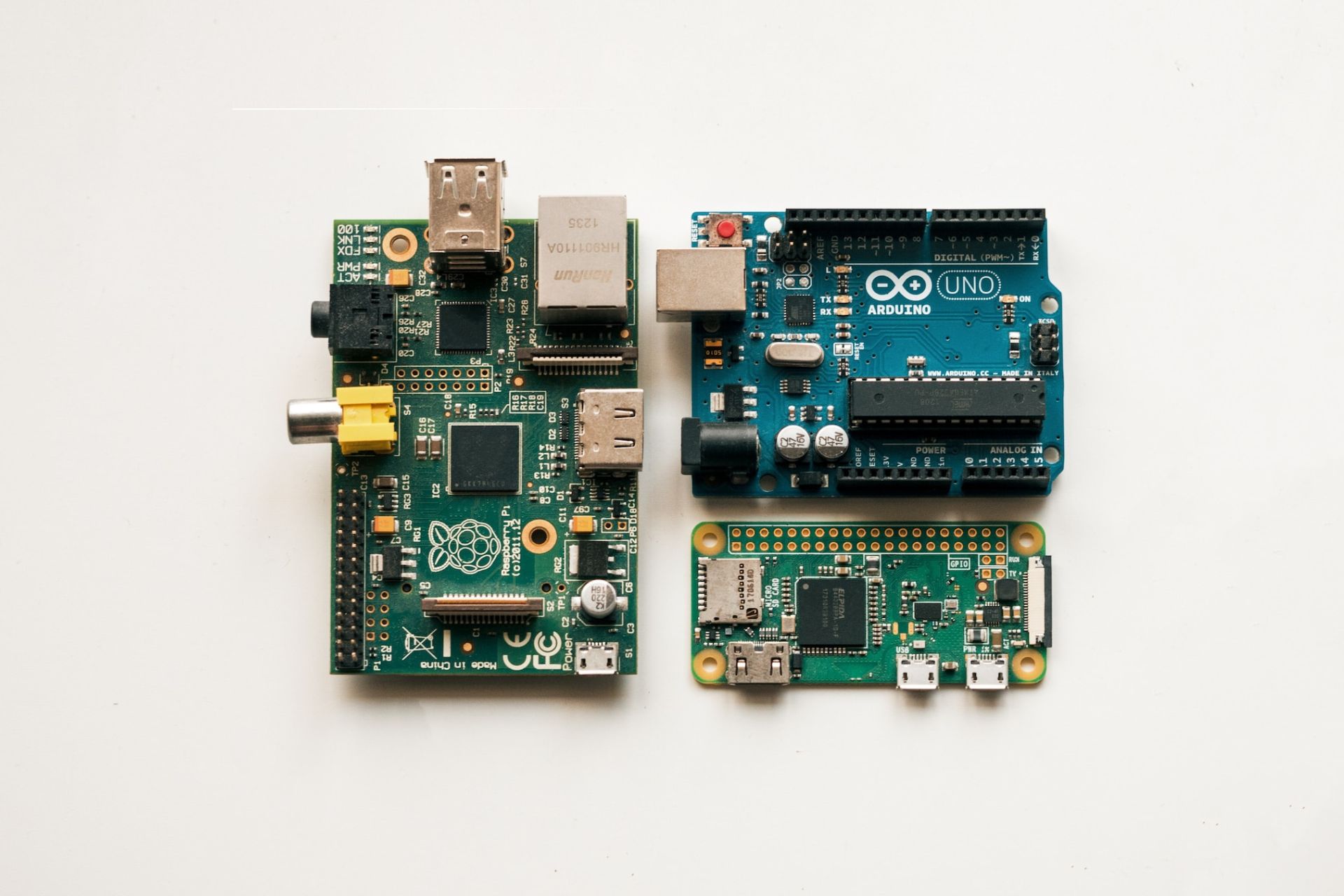



Revolutionized is reader-supported. When you buy through links on our site, we may earn an affiliate commision. Learn more here.
What are the top Raspberry Pi alternatives to check out in 2024? The Raspberry Pi is arguably the most popular microprocessor in the world. It’s hard to beat for DIY projects and prototyping alike. If you’re looking for a different microprocessor to try out, though, you’ve got plenty of other great boards to choose from. Take a look at these top six Raspberry Pi alternatives.
It’s hard to compete with the Raspberry Pi, but the Libre Computer Board AML-S905X-CC comes close. Also known as “Le Potato,” this board is widely available for under $40 USD. While it’s a few years older than the Raspberry Pi 4, the Potato is still a highly capable microprocessor with plenty of support and accessories available.
If you’re familiar with the Raspberry Pi 3, you’ll recognize the organization of this board. It was designed to compete with the Pi 3 in both layout and performance. The Potato mostly succeeds, with the notable exception of ports for a display or camera (which the Pi 3 does have).
Some people who have compared Raspberry Pi with this alternative say the option from Libre offers 50%-60% of the Raspberry Pi 4’s compute performance. Testers say Le Potato consumes about half the power of Raspberry PI 4 while idle and under full load, which is another thing to consider for those considering it.
There are also some tempting bespoke accessories, such as a case or heatsink. A possible downside is that Le Potato lacks built-in Wi-Fi. However, that is likely not as much of a problem as it may seem initially. People can buy adapters for approximately $10. The many available slimline accessories mean users can add Wi-Fi in barely noticeable ways.
Many Raspberry Pi alternatives are geared toward DIY hobbyists, but that’s not the case with the NVIDIA Jetson Nano. This microprocessor is a great option for serious developers and students using the Raspberry Pi for high-power applications, even AI testing. The Jetson Nano is specifically designed for AI applications, all in a small, low-power package.
Those interested in using the Jetson Nano for future AI projects should familiarize themselves with the JetPack SDK, which provides users with the necessary foundation to proceed. Additionally, people who would like to rely on the Jetson Nano to run generative AI locally will be happy to know it can handle such applications.
Sold as a developer kit, the Jetson Nano can handle tasks like image classification, AI robotics, object detection, speech processing and more. Although the Jetson Nano is not for production use, people commonly use it to develop and test software before production occurs. It’s one of the most expensive Raspberry Pi alternatives, with an MSRP of $149, but it’s much more powerful than many other boards in this niche.
NVIDIA also offers many tutorials, libraries and support documentation for the Jetson, so it’s easy to get started with it. For example, there is an official user forum where you can get support from peers and learn how others use this Raspberry Pi alternative. If these characteristics sound appealing and the higher price point is not a problem, there are plenty of reasons to consider it.
As its name suggests, the Orange Pi 5 is built to compete with the Raspberry Pi. Depending on the model you get, the Orange Pi is actually faster than the Raspberry Pi 4, offering up to 32GB of RAM and competitive processing speeds. It has eight 2.4GHz cores and an additional four 1.8GHz cores, giving the Orange Pi a lot more resources to work with than the Raspberry Pi 4.
The Orange Pi has a good variety of ports, including HDMI and USB-C, and a GPU capable of processing high-quality video. It’s a great choice if you want a board to build your own single-board Linux computer. Thanks to the built-in 1000Mbps Ethernet connection, people can look forward to reliable connectivity and high transmission speeds. The Orange Pi 5 runs on the Orange Pi OS, which provides many of the same capabilities as an operating system on a standard computer.
Pricing varies, but the 8GB model starts at $99.99. That’s notably more than the $75 8GB Raspberry Pi 4, but the Orange Pi is available in much higher RAM capacities.
Those in the market for Raspberry Pi alternatives who love staying abreast of cutting-edge tech will appreciate that the Orange Pi 5 features a next-generation AIoT chip built for speed and power efficiency. People can expect that it will give their future AI projects a performance boost and open new possibilities.
Plus, because people can buy the Orange Pi 5 in one of three memory options, it is easy to find one best suited to how they plan to use it. Video-based applications benefit from codec that supports 8K resolution at 60 frames per second.
The ASUS Tinker Board S R2.0 is one of the best Raspberry Pi alternatives for hobbyists and students. The Tinker Board offers similar performance to the Raspberry Pi but includes more ports, including a full-size HDMI port. Both are comparable in price, as well, although the Tinker Board has a slightly faster CPU than the Raspberry Pi 4.
One major difference between these two microprocessors is Android support. It’s a built-in native feature on the Tinker Board but not on the Raspberry Pi. So, if you want to use Android for your next single-board computer project, the Tinker Board may be worth considering.
Try the high-definition codec, which supports up to 24-bit audio. Alternatively, the integrated audio jack allows you to use a microphone with this Raspberry Pi alternative. Plus, a convenient plug-in-detection feature can recognize when someone attaches a speaker or headset and automatically switch the audio output to an audio jack.
The Banana Pi BPI-M6 is designed to resemble the Raspberry Pi in form and functionality, but it has a few advantages of its own. It has a speedy quad-core 2.1GHz processor and plenty of ports, including HDMI, and built-in support for Android and Linux.
The Banana Pi beats the Raspberry Pi in processor speed. It matches up closely in virtually every other respect, though, including price. So, if you’re looking for Raspberry Pi alternatives that are near exact clones of the Raspberry Pi 4, you may want to consider the Banana Pi.
The only drawbacks to this board are the lack of community and accessories compared to Raspberry Pi, although it’s hard for any alternative to compete in that category. If you feel up to working on a project with less external support than some of the other Raspberry Pi alternatives covered so far, the Banana Pi could be an excellent choice.
The Arduino Uno is a microcontroller, which is different from a more powerful microprocessor. However, this board can still be a good alternative to the Raspberry Pi depending on the type of projects you want to work on. The Raspberry Pi is essentially a pocket-sized computer, complete with an on-board operating system. That complexity is great for some applications but overpowered for others.
If you want to build things like homemade robots or gadgets that don’t require an operating system, the Arduino Uno may be a better fit. The lack of an OS makes it somewhat simpler to work with, especially for beginners.
The Arduino Uno is good for more physical tinkering projects rather than computing projects. It’s also very affordable, often priced around $30 USD, and has a huge online community.
The Raspberry Pi is an awesome little microprocessor with a passionate fanbase. It’s not the only single-board computer on the market, though. If you can’t get your hands on a Raspberry Pi or want to check out all your options, there are plenty of other boards to choose from. The six boards on this list are among the best Raspberry Pi alternatives you can try out today.
Before choosing one, take the time to compare all the possibilities here and others you may have found. See how the specifications stack up and consider the kinds of projects you hope to complete with it.
If anyone you know and trust has tried some of these Raspberry Pi alternatives, chat with them about their experiences to learn about their top likes and dislikes. No product is perfect, but you’ll feel more confident about choosing one if people give their perspectives to help shape your decision.
Editor’s note: This article was originally published on September 4, 2023 and was updated September 20, 2024 to provide readers with more updated information.
Revolutionized is reader-supported. When you buy through links on our site, we may earn an affiliate commision. Learn more here.


This site uses Akismet to reduce spam. Learn how your comment data is processed.